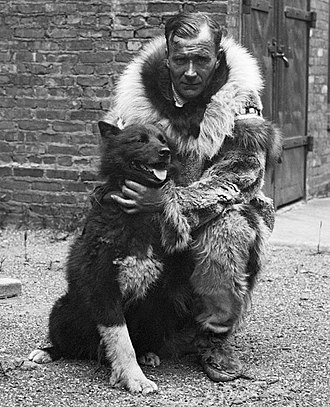Gunnar Kaasen
Gunnar Kaasen (March 11, 1882 – November 27, 1960) was a Norwegian-born musher whose heroic delivery of diphtheria antitoxin in 1925 played a pivotal role in curbing a major epidemic in Nome, Alaska. Kaasen's extraordinary efforts, which marked the final leg of a dog sled relay, are still celebrated in history<ref>,
The Serum Run of 1925: Gunnar Kaasen's Epic Journey, ,</ref>.

Early Life[edit]
Kaasen was born on March 11, 1882, in Norway. Little is known about his early life before his immigration to the United States, where he eventually became renowned for his mushing skills, particularly those demonstrated during the 1925 serum run to Nome.

1925 Serum Run to Nome[edit]
In the winter of 1925, a diphtheria epidemic threatened the small city of Nome, Alaska. With the city's supply of antitoxin insufficient to halt the outbreak, a daring plan was enacted to transport a cylinder containing 300,000 units of diphtheria antitoxin by sled dog relay from Nenana to Nome, a distance of nearly 700 miles through harsh winter conditions.
Kaasen, commanding his lead sled dog Balto, embarked on the final leg of the relay. Facing blizzards and freezing temperatures, Kaasen and his team successfully delivered the lifesaving antitoxin to Nome, effectively halting the progression of the epidemic. This feat demonstrated not only Kaasen's skill and resilience as a musher but also the crucial role of sled dogs in Arctic survival and transportation during this era<ref>,
The 1925 Serum Run to Nome: The History of a Medical Emergency, the Role of Dogs, and the Birth of the Iditarod Race, ,</ref>.
Legacy[edit]
Gunnar Kaasen's actions during the 1925 serum run have since become a symbol of determination and bravery. The annual Iditarod Trail Sled Dog Race serves as a tribute to the serum run and the vital role of mushers and sled dogs in Alaskan history. Kaasen's lead dog, Balto, was immortalized with a statue in New York City's Central Park and is recognized as a symbol of service and loyalty.
Kaasen passed away on November 27, 1960. His legacy lives on in the annals of Alaskan history and in the stories of those who brave the frozen wilderness<ref>,
Gunnar Kaasen: The Musher Behind the 1925 Serum Run, ,</ref>.
See Also[edit]
References[edit]
<references group="" responsive="1"></references>
Ad. Transform your life with W8MD's Budget GLP-1 injections from $75


W8MD offers a medical weight loss program to lose weight in Philadelphia. Our physician-supervised medical weight loss provides:
- Weight loss injections in NYC (generic and brand names):
- Zepbound / Mounjaro, Wegovy / Ozempic, Saxenda
- Most insurances accepted or discounted self-pay rates. We will obtain insurance prior authorizations if needed.
- Generic GLP1 weight loss injections from $75 for the starting dose.
- Also offer prescription weight loss medications including Phentermine, Qsymia, Diethylpropion, Contrave etc.
NYC weight loss doctor appointmentsNYC weight loss doctor appointments
Start your NYC weight loss journey today at our NYC medical weight loss and Philadelphia medical weight loss clinics.
- Call 718-946-5500 to lose weight in NYC or for medical weight loss in Philadelphia 215-676-2334.
- Tags:NYC medical weight loss, Philadelphia lose weight Zepbound NYC, Budget GLP1 weight loss injections, Wegovy Philadelphia, Wegovy NYC, Philadelphia medical weight loss, Brookly weight loss and Wegovy NYC
|
WikiMD's Wellness Encyclopedia |
| Let Food Be Thy Medicine Medicine Thy Food - Hippocrates |
Medical Disclaimer: WikiMD is not a substitute for professional medical advice. The information on WikiMD is provided as an information resource only, may be incorrect, outdated or misleading, and is not to be used or relied on for any diagnostic or treatment purposes. Please consult your health care provider before making any healthcare decisions or for guidance about a specific medical condition. WikiMD expressly disclaims responsibility, and shall have no liability, for any damages, loss, injury, or liability whatsoever suffered as a result of your reliance on the information contained in this site. By visiting this site you agree to the foregoing terms and conditions, which may from time to time be changed or supplemented by WikiMD. If you do not agree to the foregoing terms and conditions, you should not enter or use this site. See full disclaimer.
Credits:Most images are courtesy of Wikimedia commons, and templates, categories Wikipedia, licensed under CC BY SA or similar.
Translate this page: - East Asian
中文,
日本,
한국어,
South Asian
हिन्दी,
தமிழ்,
తెలుగు,
Urdu,
ಕನ್ನಡ,
Southeast Asian
Indonesian,
Vietnamese,
Thai,
မြန်မာဘာသာ,
বাংলা
European
español,
Deutsch,
français,
Greek,
português do Brasil,
polski,
română,
русский,
Nederlands,
norsk,
svenska,
suomi,
Italian
Middle Eastern & African
عربى,
Turkish,
Persian,
Hebrew,
Afrikaans,
isiZulu,
Kiswahili,
Other
Bulgarian,
Hungarian,
Czech,
Swedish,
മലയാളം,
मराठी,
ਪੰਜਾਬੀ,
ગુજરાતી,
Portuguese,
Ukrainian


